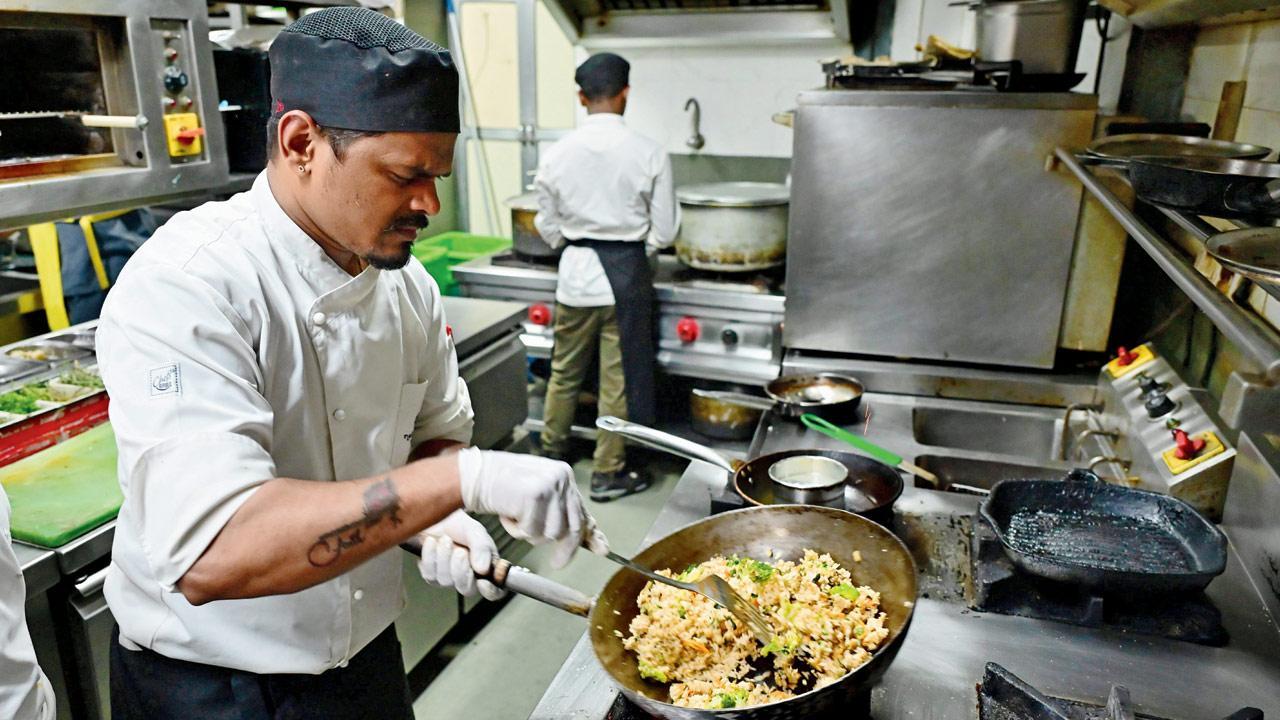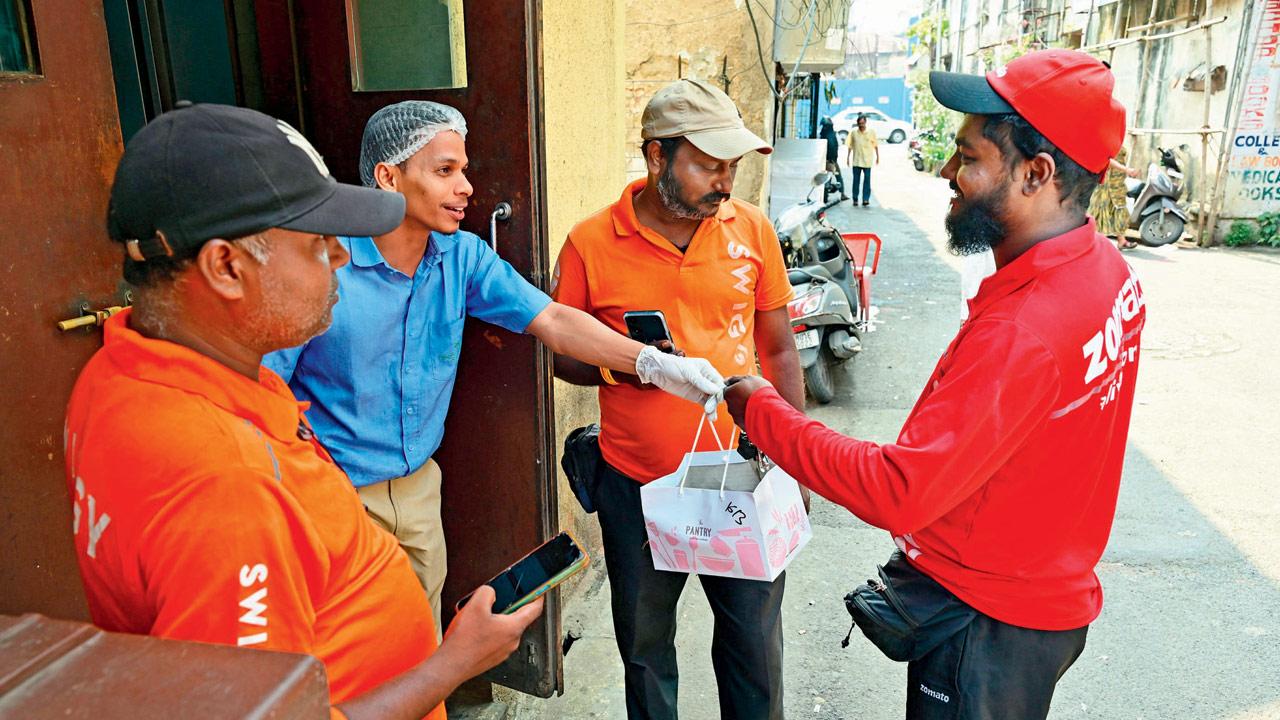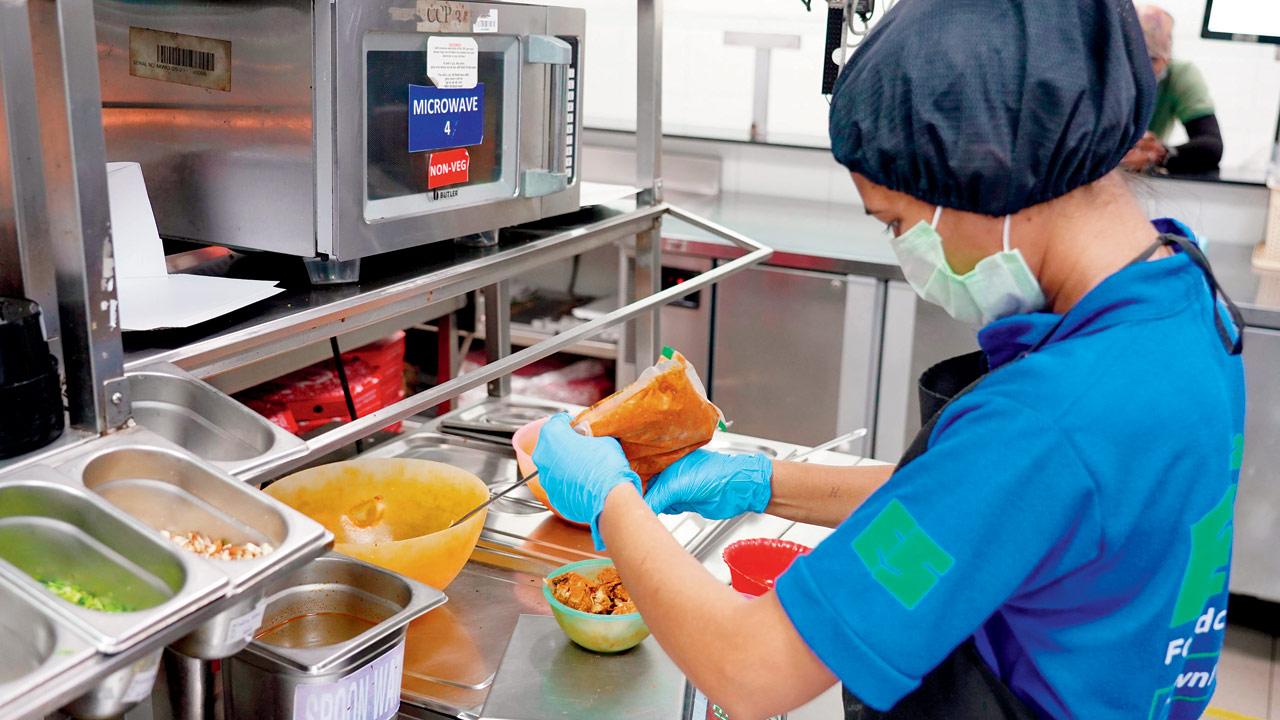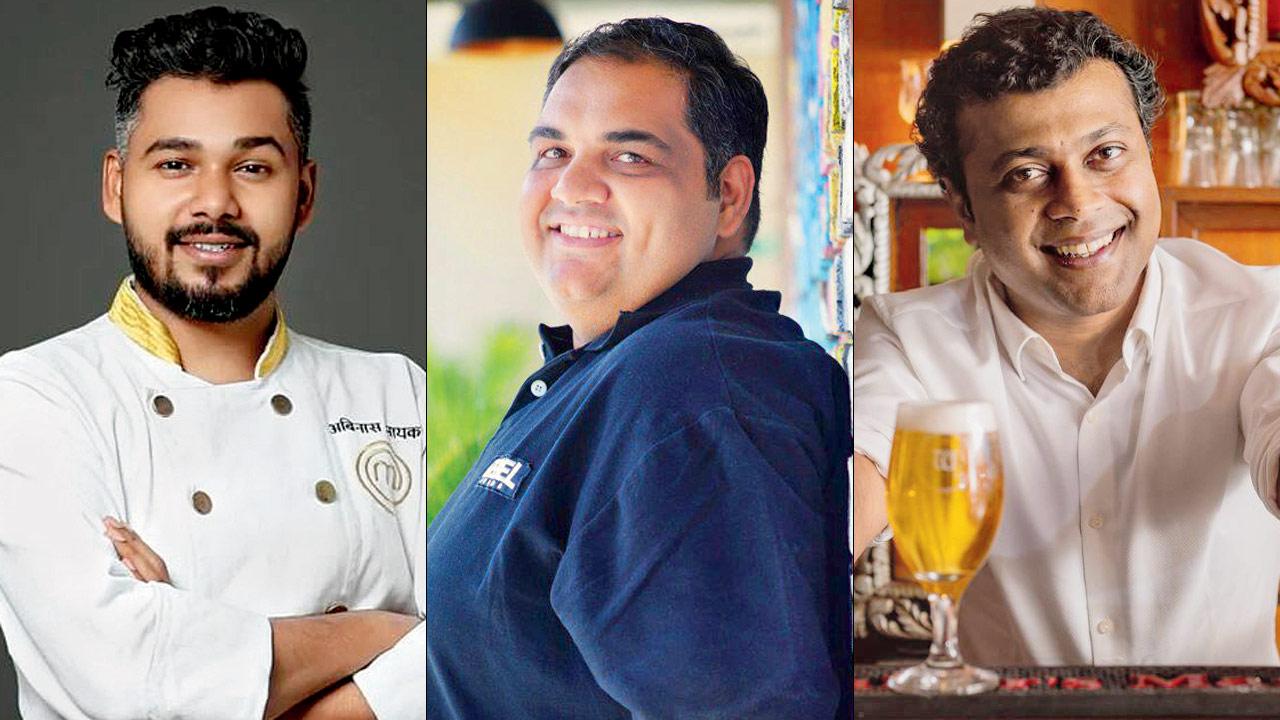Market research, AI assistance, paid boosts for visibility and a small brick-and-mortar presence helps the model thrive

A buzzing cloud kitchen of The Pantry at Fort, which moved from a dine-in restaurant to a delivery-only model after the COVID-19 pandemic. Pics/Shadab Khan
Harish Suryawanshi’s day begins before dawn when Mumbai is yet to go full throttle. He is the first to enter the kitchen in Kandivli to prepare freshly ground spices he will use for the day’s creations. Two of his trusted cooks join him by 7:30 am for a nearly 14-hour shift. His modest, home-based cloud kitchen, Smita Foods, serves Konkani and Malvani cuisines. The tiny enterprise mostly delivers in and around Kandivli. On certain occasions, when the food needs a more personal touch, his wife Smita rolls up her sleeves and joins in.
ADVERTISEMENT

Delivery partners collecting food from the South Mumbai-based cloud kitchen, The Pantry
After two years of running Smita Foods, Suryawanshi knows well that the food business is not for the faint-hearted. “People often think it is fancy. In reality, it requires full-time dedication, with longer hours on weekends and slim profit margins,” he says. For Suryawanshi, the monthly profits are to the tune of 15 per cent, but sometimes, there, they drop as low as 4 to 5 per cent as well, depending on customer orders and the festive season.
The city is flooded by the trend that took off in the mid-2010s with the rise of Swiggy and Zomato, making food delivery more accessible. Cloud kitchens, ghost kitchens or virtual kitchens are takeout and delivery only directly to customers; they can also offer back-end operations for a dine-in space. Large-scale set-ups generally have multiple brands operating under one roof, but they can also be standalone or home-based businesses.

India’s largest cloud kitchen company, Rebel Foods, has one of its biggest takeout facilities in Bhandup. It serves as a hub for back-end operations of multiple brands, catering to Mumbai’s northern suburbs. PIC/ADITI HARALKAR
However, industry figures paint a mixed picture of bottom line success. While reports valued the Indian cloud kitchen market at around R3,320 crore in 2019, with projections to reach Rs 16,600 crore by 2024, profitability remains elusive for many. A recent National Restaurant Association of India (NRAI) survey revealed that over 60 per cent of cloud kitchens struggle to profit, mainly due to the hefty commissions charged by delivery platforms. As Suryawanshi notes, “I can’t afford the 25 per cent plus commission Swiggy and Zomato take on orders. Ten percent seems like a viable number for me.”
However, regulation loopholes have allowed some to thrive by taking advantage of the reduced overhead costs of running a dine-in space and the round-the-clock demand that delivery platforms enable. An experienced restaurateur from Borivli, speaking anonymously, credits the cloud model for his business’s exponential growth. With two restaurant outlets in Borivli, he operates three cloud kitchens serving areas from Malad to Mira Road. “It’s not just because restaurants need BMC permission to stay open all night,” he says, breaking down the strategy.

Abhinas Nayak, Ankush Grover and Pankhil Shah
“If I had three physical restaurants, I’d need prime locations, face sky-high electricity bills, and pay salaries for cashiers, watchmen, and valets. On top of that, I’d need multiple licences—from fire safety to elevator permissions—all from the municipality,” he points out. The investment per restaurant would have been to the tune of Rs 15 lakh each, including the cost of interiors, professional kitchen and equipment, a per month rent of at least R1 lakh on the main road (for a 500 sqft area).
A cloud-model changes the game. Our friendly restaurateur rents three 1BHK apartments (unfurnished) for R20,000 per month (R2.4 lakh/year), and there’s no need for a restaurant licence—all he needs is a housing agreement. The rent is a fraction of the cost, and the kitchens operate round-the-clock, free from police interference. Swiggy and Zomato drive his late-night sales, catering through apps and call centre workers finishing shifts in the early hours. “It’s a fantastic setup,” he says.
However, this success starkly contrasts smaller cloud kitchens like Suryawanshi’s which caters to individual customers and where long hours yield little reward. The monthly profit margin for the Borivli restaurateur is over 50 per cent on average, compared to the average profit of 10-12 per cent for Suryawanshi’s business.

Smita Harish Suryawanshi and Randheer Bhardwaj
Ahmedabad-based restaurant coach Randheer Bhardwaj, who has over two decades of experience in F&B marketing, asks, “Restaurants develop loyal customers over time… Are people likely to order from a restaurant they know or take a chance on a place they have never heard of?” His point is clear. “People will choose familiarity.”
He goes on to elaborate: “The biggest challenge with cloud kitchens is invisibility. They only exist online, and there are too many of them. Many cloud kitchen owners think they can cut costs by not opening a traditional restaurant. But it comes at the price of visibility that comes with a physical space. Hundreds of people see a restaurant in a prime location; you cannot replicate that natural footfall with an online presence. Cloud kitchens have to spend heavily on food delivery apps just to grab attention, and even then, there’s no guarantee that people will order from them.”
The cost of advertising on food delivery apps varies, but according to Bhardwaj, businesses typically spend around R550 per day to generate sales of just R200-R300, hoping that some customers will turn into loyal regulars. Zomato and Swiggy reportedly charge anywhere between 9 to 25 per cent commission per order, exclusive of payment gateway charges and GST.
A Swiggy official, requesting anonymity, told Sunday mid-day, “The business teams make these decisions that how much commission would be charged… It depends on the vendor.” Giving the example of a famous pizza chain, he said, “If it’s an established international brand, we may not even charge a commission from them. And since there is only one competition, i.e., Zomato, the rates are similar.” He added, “For platform exclusive brands, the commission is on the lower side.”
However, Bhardwaj admits that, “There is no long-term success plans in the food business. Globally, 80 per cent of food ventures shut down within the first three years. So the profits too should come in quick.”
Rebel Foods, which operates brands such as Faasos, Behrouz Biryani, Oven Story, Mandarin Oak, and Lunch Box, started operations in Mumbai in 2011 and is now spread across India. During its early stages, the umbrella brand conducted a survey. “Not many people had seen an outlet of Faasos,” says Ankush Grover, Co-founder and CEO, adding, “But online sales were decent.” So his team moved out from premium spaces in Powai and Bandra to rental kitchens from where delivery was easy, like Bhandup, where they have their biggest kitchen setup in Mumbai. On average, they save R1.5 lakh a month per outlet in rent. But by then, Faasos had already established a strong brand presence before going cloud, says Grover.
Box8 and EATFIT are other success stories. BOX8 generally has flagship stores in prime areas, supported by a couple of cloud kitchens to bolster online demand in a particular area. A similar story unfolded for The Pantry, a Fort-based brand that operated as a restaurant for eight years until the COVID-19 pandemic forced it to shut its dine-in services and transition to a delivery-only model. Pankhil Shah, its co-founder, now runs a cloud kitchen for three brands—Woodside Burger Shop, Woodside Inn, and The Pantry. “We had the advantage of an existing loyal customer base,” he explains. “People were familiar with our USP of healthy food options. We also identified a gap in the online delivery space for guilt-free nourishment, which helped us.”
Shah adds, “The sales for our delivery-only model post the pandemic are about 35-40 per cent of pre-pandemic sales. But our costs have reduced by 80-90% given that we don’t really have a physical store.” However, having a solid brand name doesn’t always guarantee success. Masterchef India winner (2019) Abhinas Nayak, who runs two cloud kitchens in Mumbai, highlights the importance of market research before setting up a cloud business. Despite his credentials, Nayak faced challenges promoting his brand—Rroshashala—on Swiggy and Zomato, spending substantial amounts on visibility.
“Cloud kitchens can only thrive if you already have brand recognition and a loyal customer base, typically from operating as a restaurant before transitioning to a delivery-only model. Most successful cloud kitchens followed this model. The thinking shouldn’t be ‘We just need to cook’. The margins can be very narrow,” he explains.
Nayak points out that larger cloud kitchens have the advantage of advanced technology and artificial intelligence, allowing them to predict demand for specific food items during festivals. These AI tools are custom-made to suit the brand’s needs. They also analyse past data to minimise food wastage, which results in profit. “Smaller cloud kitchens can apply these insights on a limited scale. Those attempting to expand without this knowledge are often set up for failure,” he says.
Giving a practical example of how data is used, he explains, “A small outlet might make multiple types of hummus and dips daily without any data or research on which ones willdo best, leading to wastage. But when peak festival seasons arrive, they often fail to scale up effectively. The best approach is to partner with a larger cloud kitchen to understand how they function, or invest in understanding the business through research and available literature.”
He adds that brand value can also help negotiate better commission rates with food delivery platforms, a significant advantage that smaller businesses often miss out on, leading to greater financial strain.
 Subscribe today by clicking the link and stay updated with the latest news!" Click here!
Subscribe today by clicking the link and stay updated with the latest news!" Click here!







